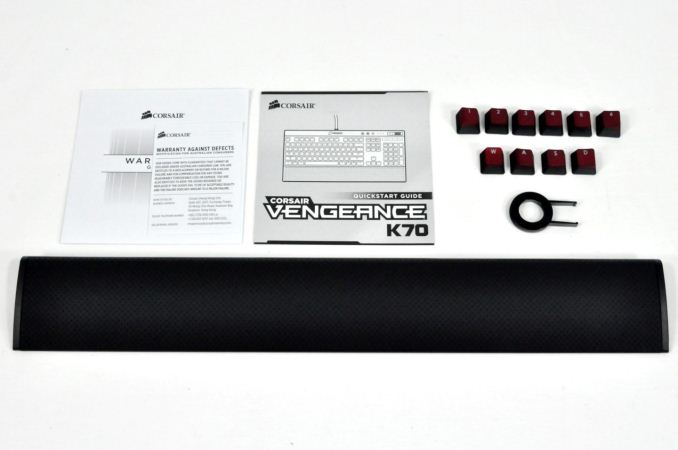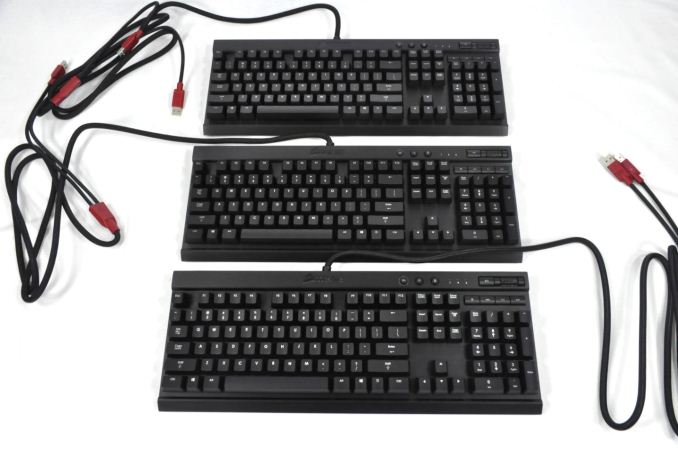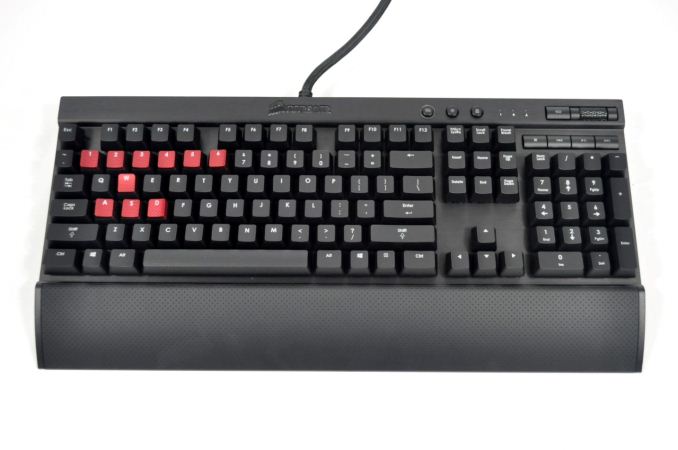Corsair Vengeance K70 Keyboard Review
by E. Fylladitakis on June 9, 2014 11:30 AM EST- Posted in
- Keyboard
- Corsair
- Cherry MX
- mechanical

Introduction
Mechanical keyboards are far from a new technology; they are decades old and some of the first mass produced personal computers came with mechanical keyboards back in the 1980's. However, due to their high production cost, they were soon replaced by keyboards other types of electronic switches that were considerably less expensive. Over the years however, the production cost of the mechanical key switches also came down, making them more and more affordable by the day. Today, PC users can find a good selection of mechanical keyboards from numerous manufacturers available at (generally) reasonable prices.
Today we will be having a look at the Vengeance K70 from Corsair, a full size keyboard designed for gaming. It is an upgrade of the popular Vengeance K60 and it is remains strikingly similar visually; however, aside from the various upgrades that we will discuss in this review, Corsair also offers the K70 in various color and switch combinations. In this review we will be looking at the black US layout version of the Vengeance K70, which features red backlighting and comes in three switch types (red, blue or brown), as well as in various layouts. Corsair recently launched the RGB LED backlit model at Computex, but that was not available when we started this review.
The Corsair Vengeance K70 Mechanical Gaming Keyboard
The first upgrade over the Vengeance K60 can be found in the bundled items. With the Vengeance K70, Corsair supplies a set of ten textured red keys (1-6, W, A, S, D—the standard gaming keys for FPS games) and a full-size wrist rest, where the older K60 only came with a small 5" wide wrist rest for your left hand while gaming.
Corsair supplied us with the three black US layout versions they produce, each featuring a different Cherry MX switch. The three keyboards are aesthetically the same and no one will be able to tell the difference between them before a keycap is removed. Once a keycap is removed or an experienced user presses a key, the difference between the Blue, Brown and Red switches become apparent. Corsair, at least for the time being, does not offer the Vengeance K70 with Cherry MX Black, Green or other switches.
Visually, the Vengeance K70 stands out from the crowd by following the same design that made the Vengeance K60/K90 popular. The keyboard is built on a brushed aluminum chassis, with the keys levitating over it rather than being embedded into it. Aesthetics are a subjective matter and some people like this design while others hate it. From a practical point of view however, this design is extremely helpful to those that like to keep their keyboards clean, as a simple blow can remove all debris from the surface of the keyboard. A primary aesthetic flaw however is the black company logo at the middle top part of the chassis. Although the logo looks very good on a silver keyboard, I feel it was a poor choice to keep the same logo on the black version of the Vengeance K70. A less important flaw are the screws that keep the motherboard together; most of them are behind keys and invisible, but a few are at places that are somewhat noticeable, such as beneath the Esc key.
Corsair installed multimedia control buttons and a volume knob at the upper right side of the keyboard. There are four keys for playback control (Play/Pause, Stop, Forward and Back) and a volume mute key next to the metallic volume knob. Three smaller keys can be found towards the top center of the Vengeance K70; one that controls the lighting, one that switches the backlight into the "gaming" mode, and one that renders the Windows keys inactive. Between these and the multimedia keys, there are three tiny white LED lights serving as the three standard key lock indicators (Caps Lock, Num Lock, Scroll Lock).
Although the installation of the textured red keys gives the Vengeance K70 a nice, aggressive gaming appearance, we found that these keys are more than just useless to any user that will not play a game using these specific keys. The keys are contoured, which gives them a nice feeling while gaming, but they feel terrible when doing anything else, especially typing. Therefore, unless you are planning to use the keyboard exclusively for playing games that are making use of these exact keys, replacing them each time you want to play a game feels like too much of a hassle.
Corsair installed a single USB 2.0 port at the top back side of the Vengeance K70. Right next to the USB port there is a switch that allows the user to change the polling rate. This function is not needed for any modern system but it increases the keyboard's compatibility with older motherboards and cheap KVM switches, which cannot operate properly when the polling rate is too high. The default polling rate of the Vengeance K70 is 1 ms (or 1 kHz). Beneath the keyboard are four feet for height adjustment, two at the rear and two at the front of the keyboard. Although stands at the rear of the keyboard are quite common, very few designs have the ability to adjust the tilt at the front.





















61 Comments
View All Comments
Antronman - Tuesday, June 10, 2014 - link
You should've gotten a keyboard with MX Black, since those are rated for ~50 million clicks.jeffmills2 - Tuesday, June 10, 2014 - link
You can game on Linux. I dual boot between Windows 7 and Ubuntu and I want the RGB version of this keyboard. I play what games I can on Linux, the rest I play on Windows. I have the Corsair Vengeance 2100 headset and the M95 gaming mouse and they're both great, except the software that let's me program macros for the mouse and optimize the headset is Windows only. I don't think it's unreasonable to request that Corsair make their PC hardware work in Linux... or at least give the community open access so we can make it work ourselves.Black Obsidian - Tuesday, June 10, 2014 - link
I own a Logitech G710+ (Cherry MX Brown), and although I *have* a Windows gaming PC, I actually use this keyboard at the office. That's where I do most of my typing, and thus most appreciate the tactile feedback of the mechanical switches. And I have the macro keys bound such that I can just spam all 6 of them in a row first thing in the morning and my whole dev environment launches.domboy - Tuesday, June 10, 2014 - link
I also have a G710+ at work that I use with a Linux workstation. This keyboard apparently also used to have issues with Linux, but something in more recent distributions/kernels must have resolved the issues as I've had no trouble in the couple months I've had it. Just because it's marketed as a gaming keyboard doesn't mean it has to be used that way. Corsair needs to fix the issue.Impulses - Tuesday, June 17, 2014 - link
It's not like any one feature makes it strictly a gaming keyboard... Shoot, I only use the backlight on my K90 when I'm coding late at night, and I only use the macro keys for stuff like Lightroom & PS shortcuts. Even the media keys and my choice of red switches aren't solely driven by gaming needs. I've actually thought about getting a more compact TKL for gaming so my mouse is closer but ehh, I like the K90 so much.duynguyenle - Monday, June 9, 2014 - link
On Pg 1, the polling rate is wrong (1ms = 1kHz, not 1Mhz...)E.Fyll - Monday, June 9, 2014 - link
Thank you, that is correct and it was a typo on my part, the error has been corrected.DanNeely - Monday, June 9, 2014 - link
What's with the dual USB ports? Do they need the extra power for all the backlighting, or is it something else?basickler - Monday, June 9, 2014 - link
There is a USB pass through on the keyboard. Hence the 2nd USB plug.ss284 - Monday, June 9, 2014 - link
It's not a passthrough, It's for extra power. The keyboard generally works fine with one USB port, but I've had issues waking from sleep with only one USB plugged in.